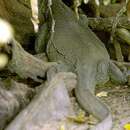ar
الأسماء في صفحات التنقل


A Water Monitor that measured 1.2m once consumed a snake that was 1.3m long. Another individual had consumed a turtle with a carapace of 16 X 10.5cm (the length of the water monitor was 2m) (Steel, 1996).
Although killed extensively for its skin, this species seems to be resilient. It has been proposed that this is because large females, who produce larger clutches, are avoided by the leather trade (Steel, 1996).
US Federal List: no special status
CITES: appendix ii
IUCN Red List of Threatened Species: least concern
Skins of Varanus salvator are used for dietary protein, ceremonies, medicine, and leather goods. Annual trade in these skins may reach more than 1 million whole skins a year, mostly in Indonesia for the leather trade. Medium-sized individual are preferred because the skin of large animals is too tough and thick to shape (Shine, 1996).
There is small trade in live monitors, but they are not suitable pets for a majority of the owners.
The Water Monitor is an extreme carnivore. This means that the lizard will eat about any animal that it believes it can consume (see additional comments). Among some of the common prey includes: birds and their eggs, small mammals (especially rats), fish, lizards, frogs, snakes, juvenile crocodiles, and tortoises. Like the Komodo Dragon, the Water Monitor has been known to dig up corpses of humans and devour them as well.
The primary hunting technique used by Varanus salvator, as well as by other monitors, is characterized by 'open pursuit' hunting, rather than stalking and ambushing. The lizard is very fast for it size due to its powerful leg muscles (Shine & Harlow, 1996).
While hunting for aquatic prey, Varanus salvator can remain submerged for up to 30 minutes (Taylor, 1963).
Varanus salvator occurs throughout much of southern Asia, from India in the west to the Philippines and the Indo-Australian islands in the east.
Biogeographic Regions: oriental (Native )
Varanus salvator is semi-aquatic and has a wide range of habitats. They are frequently seen on river banks and in swamps. The Water Monitor is a water-dependent species and has been known to cross large stretches of water, explaining its wide distribution.(Taylor, 1966).
Though also found on flat land, a typical burrow is in a river bank. The entrance starts on a downward slope but then increases forming a shallow pool of water. The average length is about 9.5 m, the average depth is about 2 m, and the average temperature is around 26 degrees Celsius (Traeholt, 1995).
Terrestrial Biomes: forest
Aquatic Biomes: rivers and streams
Average lifespan
Status: captivity: 10.6 years.
Varanus salvator is reported to grow to 3 meters in length, but most adults are 1.5 meters long at most. Individuals have a black temporal band edged with yellow that extends back from each eye. The neck of this monitor is very long with an elongated snout. The nostrils are close to the end of the nose. The tail is laterally compressed and has a dorsal keel. The scales on the top of the head are relatively large, whil those on the back are smaller in size and are keeled.
The color of the Water Monitor is usually dark brown or blackish, with yellow spots on the underpart of the lizard. The yellow markings on the species tend to diminish as the individual becomes older (Steel, 1996).
Males are normally larger than the females, usually twice as large in mass. The maturation of the male occurs when the individual is about 1-meter in size and the female at about 50-cm. The breeding season begins in April and lasts until October. However the testes of the male are the largest during April and the female is more receptive, thus there is an increase in reproductive success the earlier fertilization takes place (Shine, 1996).
Larger females produce a larger clutch size than smaller individuals. The eggs are usually deposited along rotting logs or stumps.